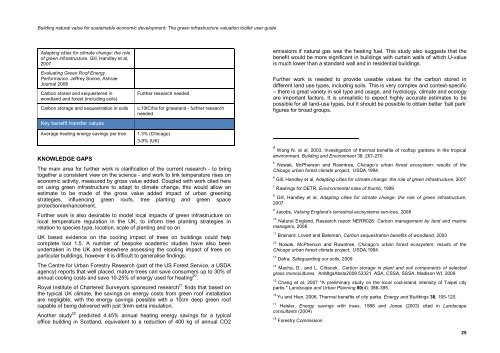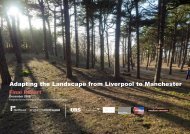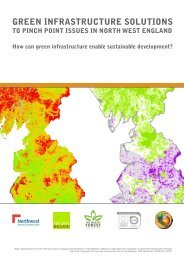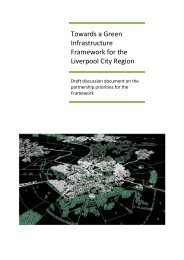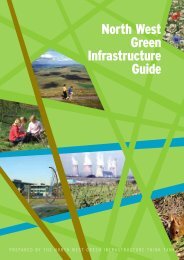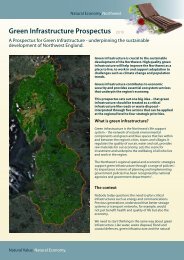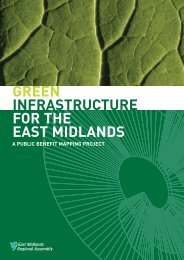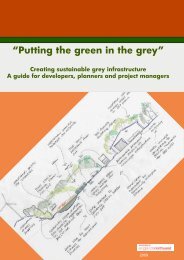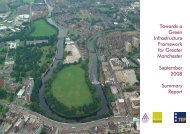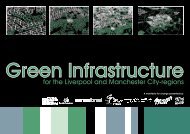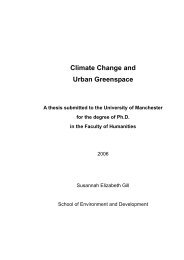The green infrastructure valuation toolkit user guide
The green infrastructure valuation toolkit user guide
The green infrastructure valuation toolkit user guide
Create successful ePaper yourself
Turn your PDF publications into a flip-book with our unique Google optimized e-Paper software.
Building natural value for sustainable economic development: <strong>The</strong> <strong>green</strong> <strong>infrastructure</strong> <strong>valuation</strong> <strong>toolkit</strong> <strong>user</strong> <strong>guide</strong><br />
Adapting cities for climate change: the role<br />
of <strong>green</strong> <strong>infrastructure</strong>. Gill, Handley et al,<br />
2007<br />
Evaluating Green Roof Energy<br />
Performance. Jeffrey Sonne, Ashrae<br />
Journal 2006<br />
Carbon stored and sequestered in<br />
woodland and forest (including soils)<br />
Carbon storage and sequestration in soils<br />
Key benefit transfer values<br />
Average heating energy savings per tree<br />
Further research needed<br />
c.10tC/ha for grassland - further research<br />
needed<br />
1.3% (Chicago)<br />
3-9% (UK)<br />
emissions if natural gas was the heating fuel. This study also suggests that the<br />
benefit would be more significant in buildings with curtain walls of which U-value<br />
is much lower than a standard wall and in residential buildings.<br />
Further work is needed to provide useable values for the carbon stored in<br />
different land use types, including soils. This is very complex and context-specific<br />
– there is great variety in soil type and usage, and hydrology, climate and ecology<br />
are important factors. It is unrealistic to expect highly accurate estimates to be<br />
possible for all land-use types, but it should be possible to obtain better ‘ball park’<br />
figures for broad groups.<br />
4 Wong N. et al, 2003. Investigation of thermal benefits of rooftop gardens in the tropical<br />
KNOWLEDGE GAPS<br />
<strong>The</strong> main area for further work is clarification of the current research - to bring<br />
together a consistent view on the science - and work to link temperature rises on<br />
economic activity, measured by gross value added. Coupled with work cited here<br />
on using <strong>green</strong> <strong>infrastructure</strong> to adapt to climate change, this would allow an<br />
estimate to be made of the gross value added impact of urban <strong>green</strong>ing<br />
strategies, influencing <strong>green</strong> roofs, tree planting and <strong>green</strong> space<br />
protection/enhancement.<br />
Further work is also desirable to model local impacts of <strong>green</strong> <strong>infrastructure</strong> on<br />
local temperature regulation in the UK, to inform tree planting strategies in<br />
relation to species type, location, scale of planting and so on.<br />
UK based evidence on the cooling impact of trees on buildings could help<br />
complete tool 1.5. A number of bespoke academic studies have also been<br />
undertaken in the UK and elsewhere assessing the cooling impact of trees on<br />
particular buildings, however it is difficult to generalise findings:<br />
<strong>The</strong> Centre for Urban Forestry Research (part of the US Forest Service, a USDA<br />
agency) reports that well placed, mature trees can save consumers up to 30% of<br />
annual cooling costs and save 10-25% of energy used for heating 20 .<br />
Royal Institute of Chartered Surveyors sponsored research 21 finds that based on<br />
the typical UK climate, the savings on energy costs from <strong>green</strong> roof installation<br />
are negligible, with the energy savings possible with a 10cm deep <strong>green</strong> roof<br />
capable of being delivered with just 3mm extra insulation.<br />
Another study 22 predicted 4.45% annual heating energy savings for a typical<br />
office building in Scotland, equivalent to a reduction of 400 kg of annual CO2<br />
environment. Building and Environment 38: 267-270.<br />
5<br />
Nowak, McPherson and Rowntree, Chicago’s urban forest ecosystem: results of the<br />
Chicago urban forest climate project, USDA,1994<br />
6<br />
Gill, Handley et al, Adapting cities for climate change: the role of <strong>green</strong> <strong>infrastructure</strong>, 2007<br />
7<br />
Rawlings for DETR, Environmental rules of thumb, 1999<br />
8<br />
Gill, Handley et al, Adapting cities for climate change: the role of <strong>green</strong> <strong>infrastructure</strong>,<br />
2007<br />
9<br />
Jacobs, Valuing England’s terrestrial ecosystems services, 2008<br />
10<br />
Natural England, Research report NERR026: Carbon management by land and marine<br />
managers, 2008<br />
11<br />
Brainard, Lovett and Bateman, Carbon sequestration benefits of woodland, 2003<br />
12<br />
Nowak, McPherson and Rowntree, Chicago’s urban forest ecosystem: results of the<br />
Chicago urban forest climate project, USDA,1994<br />
13<br />
Defra, Safeguarding our soils, 2009<br />
14<br />
Macha, D., and L. Cihacek.. Carbon storage in plant and soil components of selected<br />
grass monocultures. AnMtgsAbsts2009.53321. ASA, CSSA, SSSA, Madison WI, 2009<br />
15<br />
Chang et al, 2007 "A preliminary study on the local cool-island intensity of Taipei city<br />
parks." Landscape and Urban Planning 80(4): 386-395.<br />
16<br />
Yu and Hien, 2006, <strong>The</strong>rmal benefits of city parks. Energy and Buildings 38, 105-120.<br />
17<br />
Heisler, Energy savings with trees, 1986 and Jones (2003) cited in Landscape<br />
consultants (2004)<br />
18<br />
Forestry Commission<br />
25


